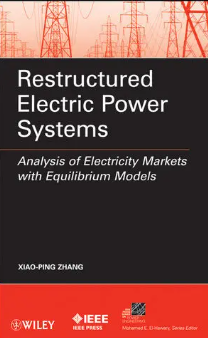
단행본
Restructured electric power systems: analysis of electricity markets with equilibrium models
- 발행사항
- Hoboken, N.J. : John Wiley & Sons, c2010
- 형태사항
- 307 p. : ill.
책 소개
The latest practical applications of electricity market equilibrium models in analyzing electricity markets
Electricity market deregulation is driving the power energy production from a monopolistic structure into a competitive market environment. The development of electricity markets has necessitated the need to analyze market behavior and power. Restructured Electric Power Systems reviews the latest developments in electricity market equilibrium models and discusses the application of such models in the practical analysis and assessment of electricity markets.
Drawing upon the extensive involvement in the research and industrial development of the leading experts in the subject area, the book starts by explaining the current developments of electrical power systems towards smart grids and then relates the operation and control technologies to the aspects in electricity markets. It explores:
목차
PREFACE.
CONTRIBUTORS.
1 FUNDAMENTALS OF ELECTRIC POWER SYSTEMS (Xiao-Ping Zhang).
1.1 Introduction of Electric Power Systems.
1.2 Electric Power Generation.
1.3 Structure of Electric Power Systems.
1.4 Ultra-High Voltage Power Transmission.
1.5 Modeling of Electric Power Systems.
1.6 Power Flow Analysis.
1.7 Optimal Operation of Electric Power Systems.
1.8 Operation and Control of Electric Power Systems—SCADA/EMS.
1.9 Active Power and Frequency Control.
1.10 Voltage Control and Reactive Power Management.
1.11 Applications of Power Electronics to Power System Control.
References.
2 RESTRUCTURED ELECTRIC POWER SYSTEMS AND ELECTRICITY MARKETS (Kwok W. Cheung, Gary W. Rosenwald, Xing Wang, and David I. Sun).
2.1 History of Electric Power Systems Restructuring.
2.2 Structure of Electricity Markets.
2.3 Design of Electricity Markets.
2.4 Operation of Electricity Markets.
2.5 Computation Tools for Electricity Markets.
2.6 Final Remarks.
References.
3 OVERVIEW OF ELECTRICITY MARKET EQUILIBRIUM PROBLEMS AND MARKET POWER ANALYSIS (Xiao-Ping Zhang).
3.1 Game Theory and Its Applications.
3.2 Electricity Markets and Market Power.
3.3 Market Power Monitoring, Modeling, and Analysis.
3.4 Application of the Equilibrium Models in the Electricity Markets.
3.5 Computational Tools for Electricity Market Equilibrium Modeling and Market Power Analysis
3.6 Solution Techniques for MPECs.
3.7 Solution Techniques for EPECs.
3.8 Technical Challenges for Solving MPECs and EPECs.
3.9 Software Resources for Large-Scale Nonlinear Optimization.
References.
4 COMPUTING THE ELECTRICITY MARKET EQUILIBRIUM: USES OF MARKET EQUILIBRIUM MODELS (Ross Baldick).
4.1 Introduction.
4.2 Model Formulation.
4.3 Market Operation and Price Formation.
4.4 Equilibrium Defi nition.
4.5 Computation.
4.6 Diffi culties with Equilibrium Models.
4.7 Uses of Equilibrium Models.
4.8 Conclusion.
Acknowledgment.
References.
5 HYBRID BERTRAND-COURNOT MODELS OF ELECTRICITY MARKETS WITH MULTIPLE STRATEGIC SUBNETWORKS AND COMMON KNOWLEDGE CONSTRAINTS (Jian Yao, Shmuel S. Oren, and Benjamin F. Hobbs).
5.1 Introduction.
5.2 Role of the ISO.
5.3 The Hybrid Subnetwork Model.
5.4 Numerical Example for the Subnetworks Model.
5.5 Bertrand Model with Common Knowledge Constraints.
5.6 Numerical Example of Equilibrium with Common Knowledge Constraints.
5.7 Concluding Remarks.
Acknowledgments.
References.
6 ELECTRICITY MARKET EQUILIBRIUM WITH REACTIVE POWER CONTROL (Xiao-Ping Zhang).
6.1 Introduction.
6.2 AC Power Flow Model in the Rectangular Coordinates.
6.3 Electricity Market Analysis Using AC Optimal Power Flow in the Rectangular Coordinates.
6.4 Electricity Market Equilibrium Analysis.
6.5 Computing the Electricity Market Equilibrium with AC Network Model.
6.6 Implementation Issues of Electricity Market Equilibrium Analysis with AC Network Model.
6.7 Numerical Examples.
6.8 Conclusions.
6.9 Appendix.
Acknowledgments.
References.
7 USING MARKET SIMULATIONS FOR ECONOMIC ASSESSMENT OF TRANSMISSION UPGRADES: APPLICATION OF THE CALIFORNIA ISO APPROACH (Mohamed Labib Awad, Keith E. Casey, Anna S. Geevarghese, Jeffrey C. Miller, A. Farrokh Rahimi, Anjali Y. Sheffrin, Mingxia Zhang, Eric Toolson, Glenn Drayton, Benjamin F. Hobbs, and Frank A. Wolak).
7.1 Introduction.
7.2 Five Principles.
7.3 Palo Verde-Devers NO. 2 Study.
7.4 Recent Applications of Team to Renewables.
7.5 Conclusion.
Acknowledgments.
References.
INDEX.
